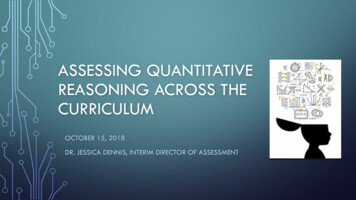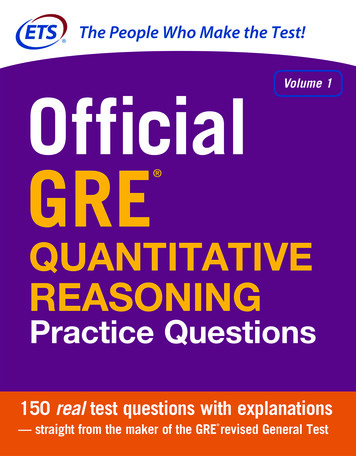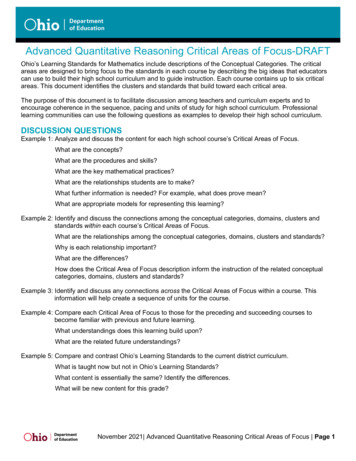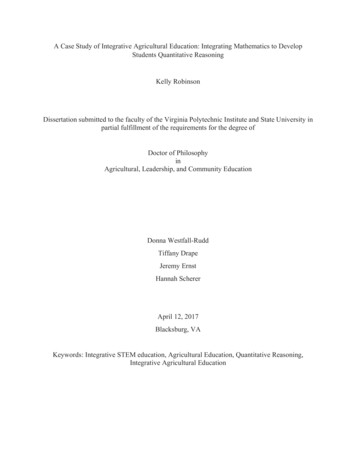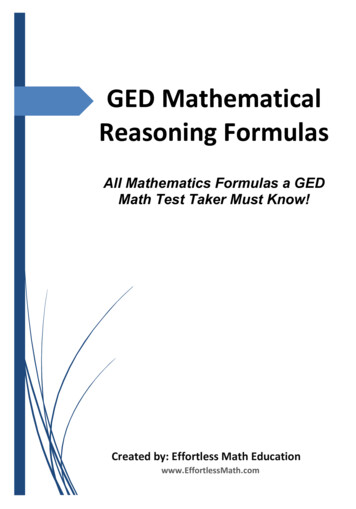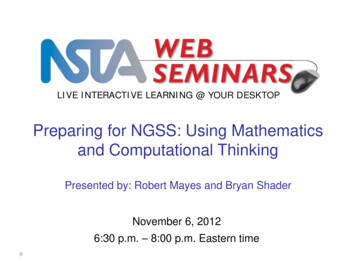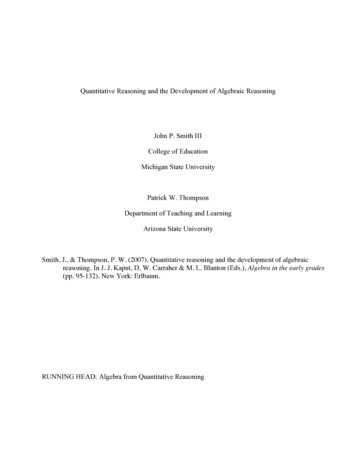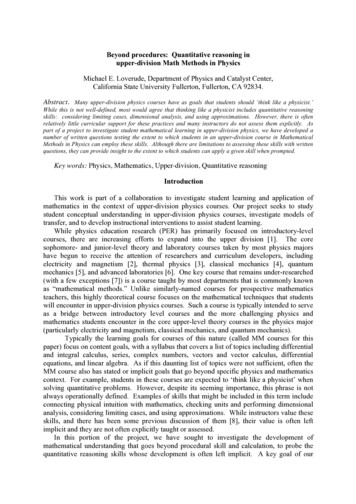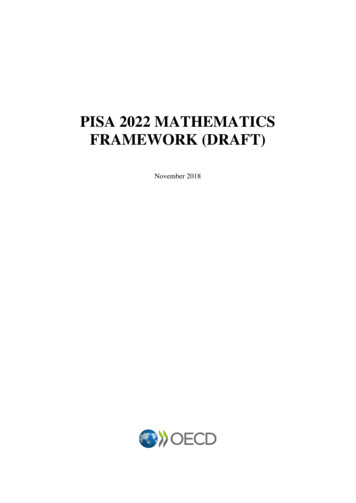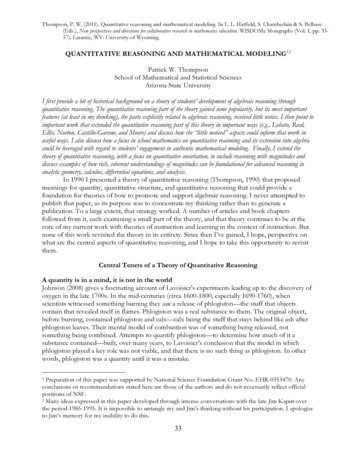
Transcription
Thompson, P. W. (2011). Quantitative reasoning and mathematical modeling. In L. L. Hatfield, S. Chamberlain & S. Belbase(Eds.), New perspectives and directions for collaborative research in mathematics education. WISDOMe Mongraphs (Vol. 1, pp. 3357). Laramie, WY: University of Wyoming.QUANTITATIVE REASONING AND MATHEMATICAL MODELING1,2Patrick W. ThompsonSchool of Mathematical and Statistical SciencesArizona State UniversityI first provide a bit of historical background on a theory of students’ development of algebraic reasoning throughquantitative reasoning. The quantitative reasoning part of the theory gained some popularity, but its most importantfeatures (at least in my thinking), the parts explicitly related to algebraic reasoning, received little notice. I then point toimportant work that extended the quantitative reasoning part of this theory in important ways (e.g., Lobato, Reed,Ellis, Norton, Castillo-Garsow, and Moore) and discuss how the “little noticed” aspects could inform that work inuseful ways. I also discuss how a focus in school mathematics on quantitative reasoning and its extension into algebracould be leveraged with regard to students’ engagement in authentic mathematical modeling. Finally, I extend thetheory of quantitative reasoning, with a focus on quantitative covariation, to include reasoning with magnitudes anddiscuss examples of how rich, coherent understandings of magnitudes can be foundational for advanced reasoning inanalytic geometry, calculus, differential equations, and analysis.In 1990 I presented a theory of quantitative reasoning (Thompson, 1990) that proposedmeanings for quantity, quantitative structure, and quantitative reasoning that could provide afoundation for theories of how to promote and support algebraic reasoning. I never attempted topublish that paper, as its purpose was to concentrate my thinking rather than to generate apublication. To a large extent, that strategy worked. A number of articles and book chaptersfollowed from it, each examining a small part of the theory, and that theory continues to be at thecore of my current work with theories of instruction and learning in the context of instruction. Butnone of this work revisited the theory in its entirety. Since then I’ve gained, I hope, perspective onwhat are the central aspects of quantitative reasoning, and I hope to take this opportunity to revisitthem.Central Tenets of a Theory of Quantitative ReasoningA quantity is in a mind, it is not in the worldJohnson (2008) gives a fascinating account of Lavoisier’s experiments leading up to the discovery ofoxygen in the late 1700s. In the mid-centuries (circa 1600-1800, especially 1690-1760), whenscientists witnessed something burning they saw a release of phlogiston—the stuff that objectscontain that revealed itself in flames. Phlogiston was a real substance to them. The original object,before burning, contained phlogiston and calx—calx being the stuff that stays behind like ash afterphlogiston leaves. Their mental model of combustion was of something being released, notsomething being combined. Attempts to quantify phlogiston—to determine how much of it asubstance contained—built, over many years, to Lavoisier’s conclusion that the model in whichphlogiston played a key role was not viable, and that there is no such thing as phlogiston. In otherwords, phlogiston was a quantity until it was a mistake.Preparation of this paper was supported by National Science Foundation Grant No. EHR-0353470. Anyconclusions or recommendations stated here are those of the authors and do not necessarily reflect officialpositions of NSF.2 Many ideas expressed in this paper developed through intense conversations with the late Jim Kaput overthe period 1985-1995. It is impossible to untangle my and Jim’s thinking without his participation. I apologizeto Jim’s memory for my inability to do this.133
PLENARY PAPERThe point that quantities are mental constructions, and that their creation is often effortful,is central to mathematics education. Too often quantities, such as area and volume, are taken asobvious, and hence there is no attention given to student’s construction of quantity through thedialectic object-attribute-quantification. Instead, textbook writers and teachers just use them toteach.Jason Silverman and I (Silverman & Thompson, 2008) pointed this out as revealed in MartySimon’s work with teachers on helping them understand multiplication as a quantifying operation(Simon & Blume, 1994). We noted that many of Simon’s pre-service teachers took a region as a unitof area, and that a measure of area was simply copying that region repeatedly to cover anotherregion and counting the number of copies. Thus, while measuring a larger rectangle with a unitrectangle those students objected when Simon turned the unit rectangle 90 degrees after coveringthe first row. They saw Simon’s method producing “overlapping areas”. They did not see Simonusing the smaller rectangle as a ruler, whereby he used its edge to measure the lengths of the largerrectangle’s edges.3 They did not see either measured area or a unit of area as being composed of twolengths combined multiplicatively.Figure 1. An “erred” measurement process (from Silverman & Thompson, 2008)In another article I described Simon’s students’ way of thinking—of units of area or units ofvolume as objects to be counted—as one-dimensional area and one-dimensional volume(Thompson, 2000) and discussed the obstacles this way of thinking poses for understandingEuclidean dimension in a way that supports understanding fractal dimension. In that article I alsodescribed children reconceptualizing multiplication as a quantitative operation. I asked a group of5th-graders the following question:Figure 2. We have a rectangle that is 4 inches wide and 3 centimeters high. Suppose we didthe silly thing and multiplied 3 by 4 to get its area. We would get 12. But 12 what?The ensuing discussion went on for 35 minutes before one child asked timidly, “Would it be12 rectangles that are 1 cm by 1 inch?” In the next 10 minutes children worked to understand how itwas that (1) it made sense, in multiplying length by width, they were somehow generating rectangles,I hasten to make clear that Simon intended to have his students experience the dilemma of whether “turningthe unit rectangle” was a legitimate way to measure the area of a larger rectangle.334
THOMPSONand (2) that the only thing they needed to know about a “covering collection” was the unit-length ofeach side of the basic area unit. To understand multiplication as a quantification of area they neededto reconceptualize one unit of area (“amount of region”) as a multiplicatively-structured object.To pre-service teachers for whom area was a thing to be covered by chunks of area,measuring area as if by a ruler made no sense. Nor did their conception of area have the property ofbi-proportionality—that if you make one dimension n times as large and another dimension m timesas large, the resulting area is nm times as large. Only covering and counting made sense. For area toentail proportionality, they needed to develop a different quantity that they would call area—onethat is created multiplicatively. To return to the example of phlogiston, those for whom the theoryof phlogiston explained combustion, phlogiston existed. It was a substance that was key to theirunderstanding of combustion. They saw it manifested in everyday experience. But they had notquantified it. In the process of attempting to quantify phlogiston, and thereby gain greater insightinto the nature of combustion, new realizations emerged.The stance that quantities are in minds, not in the world, is for educators, not scientists. Ofcourse scientists are well aware that the best they can do is build models of the way the world“really” works. But they could not do science if they did not take their models as depicting reality“as it is”. Educators, however, must be constantly aware that what is in students’ minds is whatmatters. The stance that quantities are in minds, not in the world, actively supports being attentive tohow students conceive situations and serves as an active reminder that their conceptions of even themost “obvious” aspects of a situation are likely to differ from ours in important ways.Quantification is a really big dealIn (Thompson, 1994d) I said this about quantification.Quantification is a process by which one assigns numerical values toqualities. That is, quantification is a process of direct or indirectmeasurement. One does not need to actually carry out aquantification process for a quantity in order to conceive it. Rather,the only prerequisite for a conception of a quantity is to have aprocess in mind. Of course, a person’s grasp of a process may changeas he or she re-conceives the quality and the process in relation toone another.I wish I had not said this, for it is commonly understood that I meant precisely what I said—that quantification is merely a process of assigning numbers to an attribute of an object. I didn’tmean this at all, and the remainder of that article, which analyzed one child’s construction of speedas a quantity, documented the dialectic between her progressive conceptualization of motion asentailing the simultaneous accumulation of two quantities (distance and time) and conceptualizing aquantification of that simultaneous accumulation. Here conceptualization of each—speed as aquantity and proportional correspondence as her quantification of it—went hand in hand. Theywere inseparable.Luis Saldanha and I (Thompson & Saldanha, 2003) developed another example of the powerof quantification as a root of mathematical thinking. We considered the question, “What is torqueand how might one quantify it?” While I would never claim that our conceptual analysis wasdefinitive with respect to learning the idea of torque, I believe it does reflect the dialectic betweenconceptualizing a quantity and conceptualizing its quantification. The central questions were, What is the object one conceives when conceiving torque? What is the attribute of that object that one quantifies?35
PLENARY PAPER What is one unit of torque?The answer to (1) can only be that it is a system that you are quantifying—a system thatinvolves something turning around a fixed point that somehow behaves differently the farther fromthat fixed point you are. The answer to (2) of course involves (1). The attribute of that system issomething like “amount of twist”, the awareness that it takes more shoulder strength to hold a pailof water farther from your body than closer. The answer to (3) is more complicated. It is therealization that (a) any quantification of torque must take into account, simultaneously, the distancethat a force is applied from the fixed end and the amount of force being applied (and thus a unit oftwistiness is say, Newton-meter or foot-pound), and (b) that amount of twistiness is proportional toeach of those components—if we apply the same force at thrice the distance we get thrice theamount of twistiness. If we apply thrice the force at the same distance, we get thrice the twistiness.Thus, whatever amount of twistiness is produced by 1 force-unit at 1 distance-unit, a force of nforce-units at 1 distance unit will be n times as great, and a force of 1 force-unit at a distance of mdistance-units will be m times as great. Put more formally, if T(1,1) is the amount of twistinessproduced by 1 force-unit applied at 1-distance unit from a fixed point, then T(n,1) nT(1,1) andT(1,m) mT(1,1). Therefore T(n,m) mnT(1,1). Thus, we “multiply force times distance” to quantifytorque.As an extension of this example regarding torque, and building off the ways of thinkingdescribed in (Thompson & Silverman, 2008), if students combine an understanding of torque withan understanding of accumulation, then it is not hard for them to imagine a method forconceptualizing the total torque generated by an object of varying density that has one end fixed.Imagine slicing the object into super-thin pieces that are vertical to the axis of twist, imagining eachslice to be of uniform density, and summing the torque generated by each as if each is generatestorque independently. The sum is your total torque. However, this method is unavailable to studentswho have not conceptualized torque and accumulation appropriately: torque as constitutedmultiplicatively by a force acting at a distance from a fixed point and a total amount of a quantity asgenerated by accumulating little bits of it.The dialectic between students conceptualizing a quantity and conceptualizing aquantification of it is so important that I’ll share a third example. A class of 8th-grade students incentral Illinois was curious about why grain silos explode (the news reported one having explodedthe prior day). I decided to leverage that curiosity into an ad-hoc unit on quantification—on creatingthe quantity “explosiveness” and how one might measure the explosiveness of a grain silo. Studentswere stymied until someone remembered, from science, that an explosion is just fast burning, and sosomething must burn to produce a silo explosion. Then one student remembered throwing a pinchof flour into a campfire and seeing it burst into flames. Oh, grain dust is what burns! But if graindust is all on the ground, you could hit it with a blowtorch and it wouldn’t burn. What’s going on?Another student recalled that burning is just oxidation, and that oxidation happens only at amaterial’s surface, so maybe when grain dust is all on the floor there just isn’t enough exposedsurface for it to burn. Where does that take us? Oh! When dust is on the floor, only the top, thinlayer is exposed to air. When dust is “in the air”, each individual dust particle is surrounded by air!Where does that take us? Well, maybe if we think about the amount of grain dust (by volume) inrelation to the amount of surface area exposed that will give us a measure of explosiveness? Butwait, doesn’t the size of the silo matter? Oh, you need to think of the amount of surface area inrelation to the volume of dust, per cubic foot of air in the silo. They ended, after several days ofintense debate, with a unit of measure being cm2 of “dust surface area” per cm3 of “dust volume”36
THOMPSONper ft3 of “silo volume” as their unit in which they would measure a silo’s explosiveness4. Theyfigured that there would be a low range of measurements that indicate “not explosive”, a mid-rangeof measurements that indicate “it depends on other things” (e.g., the exact composition of the dust),and a high range of measurements that indicate “highly explosive”. They wondered about how tofigure the total particulate surface area of some amount of dust, but they were confident that thiswas possible if you assumed all dust particles had a given diameter.Whether students ended with a good measure of explosiveness or a poor measure actually isnot relevant to the significance of their activity. Rather, the significance is that in coming up with ameasure that satisfied them, they needed to build from models they already had (combustionhappens at an object’s surface; explosions happen by rapid oxidation5) and they needed to engage ina dialectic between conceptualizing the attribute being measured (explosiveness and how thingsexploded) and the way in which they would measure it (by comparing relative amounts of relatedquantities).Another aspect of this example is important for school mathematics. Once students hadconceptualized explosiveness (how it works) and measures of it, we could start doing mathematics.“Suppose there are two silos having the same volume and having the same volume of grain dust inthe air, but the diameter of individual particles’ in one silo is twice the diameter of particles in theother. How explosive is one silo relative to the other?” On the other side of this example is thepoint that, without students having a working model of explosions and without them havingconceptualized a measure of explosiveness, that question would have been meaningless to them.To come full circle regarding quantification, I wish that instead of saying that quantificationis the process of assigning numerical values to a quality I had said this:Quantification is the process of conceptualizing an object and an attribute of it so that the attributehas a unit of measure, and the attribute’s measure entails a proportional relationship (linear, bilinear, or multi-linear) with its unit.Sometimes the process of quantification might take minutes, other times years, and other timesgenerations.This expanded definition of quantification, to me, provides an explicit link between scienceeducation and mathematics education. We must take quantification seriously if we want to developinstructional and curricular strategies for having students’ mathematics be of use to them in dealingwith their worlds.6 By “their worlds” I include more than students’ physical worlds. Economicsabounds with quantities that students conceptualize poorly (e.g., principal, interest, compoundedinterest, annual interest rate, monthly interest rate, profit, loss, revenue, expense, marginal cost, etc.),and which, properly conceptualized, would enable people to make wise decisions and avoid costlymistakes. Issues of scale have their conceptual roots in quantification. Paulos’ (1988) classic book onI still find it fascinating that in this sophisticated conversation they felt that they needed “small units” likecm2 and cm3 to measure attributes of dust particles, but cm3 was too small a unit to measure the volume of asilo.5 They did not consider that chemical explosions do not involve oxidation, but, again, this hardly mattershere.6 Bob Mayes noted that many science educators find my meaning of quantitative reasoning “too mathy”. Myreply, to reiterate a point that I made in (Thompson, 1994b), was that while math education must takescientific reasoning more seriously as a source of mathematical reasoning, science education must takemathematical reasoning more seriously as a source of scientific reasoning. I still maintain that scienceeducation could profit from attending with greater clarity to quantity and quantitative reasoning as I describethem here.437
PLENARY PAPERinnumeracy is an account of the consequences of our populace’s failures in quantification—of failingto conceptualize aspects of our world so that they are measurable in some unit, which completelyobstructs their ability to reason quantitatively.Quantitative operations are not the same as numerical operations (but they are related)Steffe (1991a, 1991b) provided what I consider to be the foundational analysis of the mentaloperations that generate quantity. In these papers he describes the operations of segmenting andunitizing as foundational for generating concepts of measured quantity. So, in the strict sense thatSteffe develops, operations that generate quantity and operations that generate number are tightlyrelated.Without contradicting Steffe, I’d like us to enter the world of children and teachers. Childrenoften employ numerical operations that have no quantitative significance. They might havequantitative roots, but at the moment of employing them they often do not reflect operations onquantities. They might even be highly structured with regard to numerical underpinnings, entailingcomposite units and multiplicative relationships. But again, they can do this without imaginingsomething being quantified.In 1993 I wrote about six 5th-grade children’s additive reasoning (Thompson, 1993). In thatarticle I defined difference as a quantity resulting from comparing two quantities additively—“theamount by which one quantity exceeds or falls short of another”. Thus, a difference, as a result of acomparison, is a quantity. But it is a quantity that exists within a structure: (Quantity A, Quantity B,Result of Comparing). I also gave examples of how, in a complex situation, one could potentially useany arithmetic operation, not just subtraction, to evaluate that quantity. I also gave an example of thechildren using subtraction but not knowing what quantity they had just evaluated. This exampledeserves repeating for the present conversation. It involves a rather lengthy excerpt, so I apologizein advance. I will focus upon lines 57-92, but those lines make sense only in the context of thediscussion that precedes them.Problem 2:Two fellows, Brother A and Brother B, each had sisters, Sister A and Sister B.The two fellows argued about which one stood taller over his sister.It turned out that Brother A won by 17 centimeters.Brother A was 186 cm tall.Sister A was 87 cm tall.Brother B was cm tall.Sister B was cm tall.Put numbers in the blanks so that everything works out.71. PT:Okay. Do this one as a team. Put numbers in the blanks so that everything works out.Pause as children read the text.2. Jill: (inaudible) Well, actually, Brother B has to be at least 17 cm shorter than Brother A.3. Molly: But it says that Brother A won by 17 cm.4. Jill:I know.5. Molly: So that means The children had solved a problem using the same context, but with numbers instead of blanks, so they hadalready sorted out the assumption that Brother A compared himself to Sister A and Brother B comparedhimself to Sister B.738
THOMPSON6.7.8.9.Jill:Molly:Jill:Molly:So that means he (Brother B) has to be at least 17 cm shorter Yeah, at least.No wait no it doesn’t, because not it doesn’t, because It says she could be shorter than him if the difference is small. Pause. But if Brother A wonby 17 cm, that means that Sister B must be at least 17 cm taller than Sister A.10. Jill:Uh-uh (no). If Brother B is shorter, then she can’t be.Pause.11. Jill:Well we could put 12. Molly: Like the last one we had.13. Jill:Well, you could put that Brother B was 150 cm tall and Sister B was 149 cm tall.14. Peter: How do you know that would work?15. Molly: But Brother A still has to win by 17 cm.16. Don: Oh, so Brother B yeah would be 17 oh no, he wouldn’t But he could be 17 cmshorter. He doesn’t have to be, but he could be.Pause.17. Don: I don’t think it matters what we put in there.18. Jill:Ummm Brother A had to win by 17 cm.19. Don: (Quietly.) I don’t think it matters.Molly: 20. Peter: Yes it does. Brother A has to win by 17 cm. 21. Molly: As long as he wins by 17 cm, you could put anything in.22. Peter: But what do you mean that he wins by 17 cm?23. Molly: He has to be 17 cm taller than Sister A than 24. Jill:Brother B is than Sister B.25. Peter: Oh, I know.Pause.26. PT:You have any numbers in there yet?27. All:No.28. PT:Good discussion! Are you trying to figure out what the first number is?Pause.29. Jill:Wait. Lets find out the difference between Brother A and Sister A.30. Don: It’s easy.31. Molly: It’s 99.32. Don: It’s 98 99.33. Molly: So, Sister B must be 17 cm must be 99 minus 17.34. Jill:She could be.35. Molly: She could be, because he has to win by 17 cm.36. Peter: 99 minus 17 83.37. Don: It’s 82.38. Peter: She could be 82. But what would Brother B be?39. Molly: So, she could be 82 cm tall. But she doesn’t have to be 82 cm tall.40. Jill:She could be 82 cm or lower.39
PLENARY PAPER41.42.43.44.Molly:Peter:Molly:Jill:He’d [she’d?] have to win by 17 cm Brother B?Brother A.But then Brother B can’t be we could make Brother B be 90 we could make Brother Bbe the same thing.45. Peter: You could make Brother B be 100.46. Molly: No, you couldn’t, because, then he’d be I don’t know.47. PT:What does the 82 mean?48. Jill:That’s the difference between Sister A and Brother A.49. PT:The 82 is?Jill: 50. Don: No, it isn’t. 99 is. 51. Molly: But he had to win by 17 cm, so we took away 17 from 99 So Brother B would have to bethe same as Brother A. [To Jill] We could do it that way.52. Jill:Uh-huh (yes) 53. Peter: 186 54. Jill:Then Brother B would win.55. Peter: No he wouldn’t56. Molly: Yes he would.57. PT:Could I ask you to think about something Try this. Think about what the 82 means.Long pause.58. Jill:inaudible okay, so the difference between Brother A and Sister A and subtracted uh how much he won by (to Molly) Pause.59. Molly: Huh?60. Jill: We took the difference between Brother A and Sister A. Does everybody understandthat?61. All:Yeah.62. Jill:And then we took away how much Brother A won by.63. All:Yeah.64. Molly: Yes yes yes!65. Peter: (Giggles at Molly.) So 186 66. PT:(To Jill) And you got 82, right? Now, what does the 82 stand for?Pause.67. Jill:Uhhhhh 68. All:(Giggles.)69. PT:Well, what does that 99 stand for?70. Molly: How much the difference is Oh, so the 82 could be the difference between Brother Band Sister B.71. PT:Is that what it is?72. Don: It could.73. PT:Or is that how tall Sister B is?74. Molly: It couldn’t be how tall she is because then Brother B would win.40
er:PT:Peter:Molly:Peter:No it wouldn’t. He could be 82 or more.She has to be shorter than 90 cm or taller It doesn’t matter.This would work 185 and 82.Would Brother A win by 17 cm, Peter? no.He has to win by 17 cm, so you could have Sister B be 127 cm shorter than Sister A.It could be 99. That would be 17 difference.Pause.Let’s think again. The 99 stands for what?83. PT:Jill: 84. Don: How much difference there is between Sister A and Brother A. 85. Molly: I know. I know. You can subtract 82 minus 186 and then you’d get 104. And 104 is 17 morethan 87.Pause.86. Don: Huh?87. PT:Explain it again, Molly. But instead of talking about the arithmetic, talk about what it is thatyou are thinking.88. Molly: The first thing we did was the difference between Brother A and Sister A, and it was 99. Andminus 17 is 82.89. Jill:But what was the 82 for?90. Molly: Huh?91. Jill:What does the 82 stand for?92. Molly: I don’t know.The structure of this problem is that it entails a quantitative difference that compares twoquantitative differences (see Figure 3). In lines 1-56 the children determined that Brother A stood 99cm taller than Sister A. They conceptualized the quantitative difference between their heights andsubtracted to evaluate it. In lines 57-92 they intuited that Brother A winning the argument by 17 cmmeant that the difference they found possessed an excess of 17 cm over something. In line 70 Mollywondered (correctly) whether the 82 (99-17) could be the difference between Brother B and SisterB, but her reply to my question in lines 71 and 73 suggested that this was not a necessary conclusionfor her.8 The remainder of the excerpt suggested to me that though they knew that there was acomparison between Brother B’s and Sister B’s heights, that knowledge did not bring to mind aquantitative structure in which the result of that comparison existed as a quantity in its own right.Thus, my interpretation was that these students could compare two quantities additively to form aquantitative difference, but their operation of comparison was not such that knowing that a quantityis a difference brings with it the awareness that two other quantities must be compared to produceit. This explains their inclination to try to put “82” somehow into the height of Brother B or SisterB. Not thinking of a difference as a quantitative structure is similar to students being given a speedand not thinking automatically that distance and time must be involved, too.Earlier parts of the article show clearly that the children felt free to push back when I questioned theirconclusions and they were confident in them.841
PLENARY PAPER17 cm186 cmBro A87 cmSis ABro BSis BFigure 3. Structure of the problem as a comparison of differences.So, to be clear, in my usage, quantitative operations are those operations of thought by which oneconstitutes situations quantitatively. Numerical operations are the operations by which oneestablishes numerical relationships among their measures. Quantitative and numerical operations arecertainly related developmentally, but in any particular moment they are not the same even thoughin very simple situations children (and teachers9) can confound them unproblematically.Dispositions that allow students to create algebra from quantitative reasoningEllis (2007) gives a compelling account of the important role that quantitative reasoning plays instudents’ operations of generalizing, and of the role that generalizing plays in students’ developmentof algebraic reasoning. She outlines a number of generalizing actions students employ that, whengrounded in quantitative reasoning, produce more and stronger generalizations than when studentsattempt to generalize from numerical or calculational patterns. I have little to offer that extends Ellis’work, but I believe I can say something about other processes at play both within and in addition tothe generalizing actions she identified.In (Thompson, 1990) I identified a number of dispositions and a process of abstraction thatcan aid students’ construction of algebraic reasoning from quantitative reasoning. Briefly, the are:A disposition to represent calculationsIt is common in Asian and Russian primary mathematics curricula to have students write thearithmetic they would perform to resolve a situation without calculating the result. This practice hasa salutary effect: Students can see the values of the quantities that are described in the situation andsee where these values fit into a solution. Thus, unevaluated expressions are reminders to thestudent writing them, and hints to students reading them, to the underlying quantitative structuregiving rise to the calculation. This provides opportunities for pseudo-empirical abstraction (Piaget,2001), which is to reason about the products of one’s reasoning as if reasoning about objects in theworld, which is propaedeutic for students’ eventual reflective abstraction of their reasoning.Students’ disposition to write numerical formulas
quantitative reasoning. The quantitative reasoning part of the theory gained some popularity, but its most important features (at least in my thinking), the parts explicitly related to algebraic reasoning, received little notice. I then point to important work that extended the quantitative
